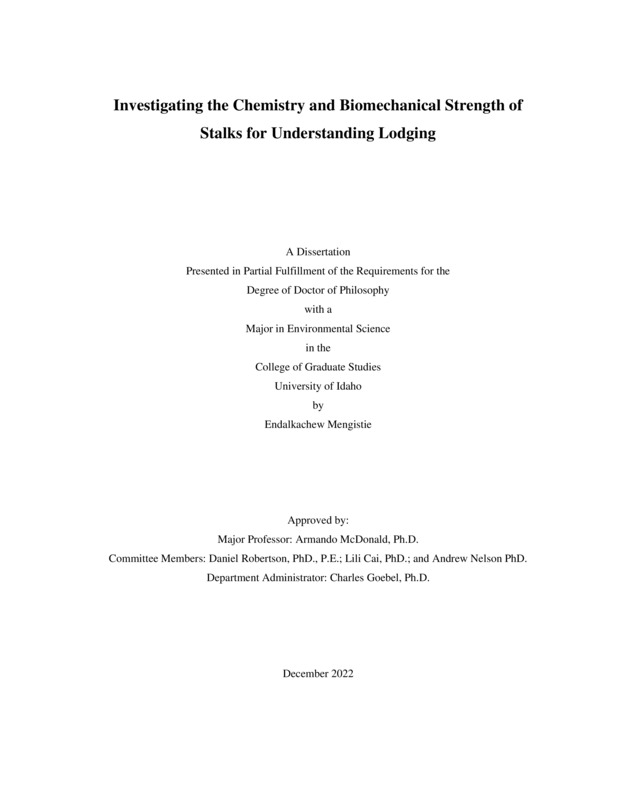Investigating the Chemistry and Biomechanical Strength of Stalks for Understanding Lodging
Mengistie, Endalkachew Chanie. (2022-12). Investigating the Chemistry and Biomechanical Strength of Stalks for Understanding Lodging. Theses and Dissertations Collection, University of Idaho Library Digital Collections. https://www.lib.uidaho.edu/digital/etd/items/mengistie_idaho_0089e_12488.html
- Title:
- Investigating the Chemistry and Biomechanical Strength of Stalks for Understanding Lodging
- Author:
- Mengistie, Endalkachew Chanie
- Date:
- 2022-12
- Program:
- Environmental Science
- Subject Category:
- Chemistry; Wood sciences; Materials Science
- Abstract:
-
Sorghum is an important crop mainly grown for food, animal feed, bioenergy, and fiber requirements. The production of a higher yield is compromised by its stalk lodging. Stalk lodging, the permanent displacement and mechanical failure of stems from their natural position prior to harvesting, poses a serious agronomic challenge leading to substantial yield losses annually. Despite its enormous economic impact on commercial crops, stalk lodging mechanisms are not clearly understood. Previous studies used methods such as bending tests, histochemical methods, rind penetrometer, and crushing strength measurements to understand stem biomechanical behavior. However, these approaches are inadequate to fully understand the lodging, as the structural composition of the stalks was not considered. Thus, approaches involving compositional analysis together with the biomechanical behavior of the crops will improve our understanding to develop lodging-resistant varieties and narrow the knowledge gap in stalk lodging mechanisms. This study evaluated stem biomechanical, compositional, and microstructural traits to assess their relationship with mechanical strength and/or loading. The whole biomass composition of Della (D) and its mutant REDforGREEN (RG) sweet sorghum stalks grown in 2018 (D1, RG1) and 2019 (D2, RG2) were examined employing different analytical instruments. Noticeable changes in the composition of fatty acids, structural carbohydrates (glucan, and xylan), and lignin content and structure were found, attributable to growing season and mutation factors. The results revealed that D2 had the highest lignin content, while RG1 had the lowest lignin content. Particularly in RG1, Klason lignin reduction by 16-44 % at the internode was detected. Lignin from the sorghum stalks were enriched in guaiacyl units and syringyl/guaiacyl ratio was increased in RG1 and RG2 respectively by 96% and more than two-fold at IN. In addition, the chemical composition, biomechanical properties of rinds, and the microfibril angle (MFA) of the S2 cell wall were determined. The flexural modulus (FM) and flexural strength (FS) showed a significant reduction for RG. Particularly, a reduction of FS by (16-37%) and FM (22-41%) were detected for RG1. Changes in the stalk rind biomechanical properties were found positively correlated with total lignin and glucan/cellulose contents, and inversely proportional to MFA. However, the contents of xylan/hemicellulose in the rinds were not significant for the strength. The result suggested that the lodging resistance of sorghum stalk would be improved by increasing the amount of cellulose and lignin. The results can also provide biotechnological targets in breeding programs aimed at improving lodging resistance in sorghum.
- Description:
- doctoral, Ph.D., Environmental Science -- University of Idaho - College of Graduate Studies, 2022-12
- Major Professor:
- McDonald, Professor Armando
- Committee:
- Robertson, Dr. Daniel; Cai, Dr. Lili; Nelson, Dr. Andrew; Goebel, Dr. Charles
- Defense Date:
- 2022-12
- Identifier:
- Mengistie_idaho_0089E_12488
- Type:
- Text
- Format Original:
- Format:
- application/pdf
- Rights:
- In Copyright - Educational Use Permitted. For more information, please contact University of Idaho Library Special Collections and Archives Department at libspec@uidaho.edu.
- Standardized Rights:
- http://rightsstatements.org/vocab/InC-EDU/1.0/

